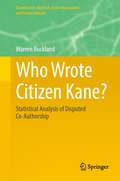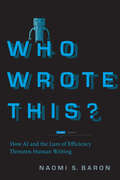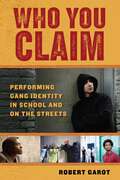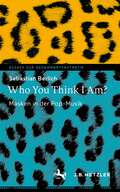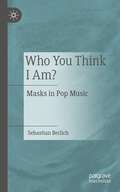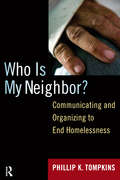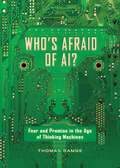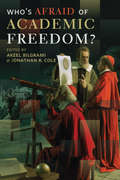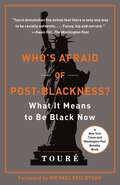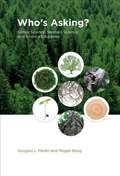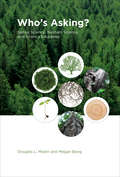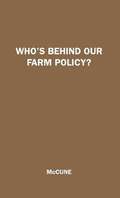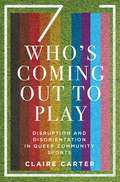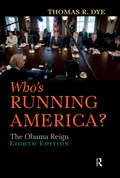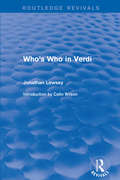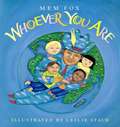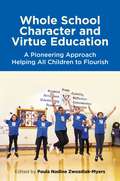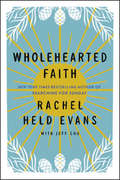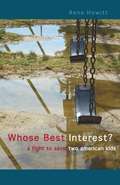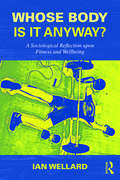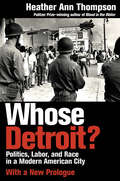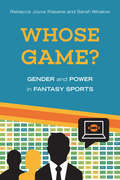- Table View
- List View
Who Wrote Citizen Kane?: Statistical Analysis of Disputed Co-Authorship (Quantitative Methods in the Humanities and Social Sciences)
by Warren BucklandThis book offers a solution to one of film history’s major controversies: the long-running dispute over Orson Welles’ and Herman J. Mankiewicz’s contributions to the Citizen Kane screenplay. It establishes the vital importance of computing and statistics to solving previously intractable puzzles in the arts and humanities. Citizen Kane (1941) is one of the most acclaimed films in the history of cinema. For 50 years it topped the Sight & Sound film critics’ poll. Orson Welles directed the film and is credited with co-writing the screenplay with Herman J. Mankiewicz. But the co-writer credit generates furious disputes between those who argue Mankiewicz is the sole author of Citizen Kane and those who claim that Welles collaborated fully with its writing. The author employs computing and statistics to answer two questions: What are the distinguishing features of Welles’ and of Mankiewicz’s writing? And What did each contribute to the writing of the Citizen Kane screenplay? To answer these questions, the author bypasses opinions and impressions, and instead subjects the language of the Citizen Kane screenplay to a ‘forensic’ examination. Employing linguistics, basic statistical tests, plus computer technology and software, the author identifies the stylistic signature of each author – the combination of consistent and regular linguistic habits that make each author’s writing distinctive. This book replaces impressionistic discussions of Mankiewicz’s and Welles’ contributions to the Citizen Kane screenplay with a rigorous, experiment-driven statistical analysis. Earlier statistical studies of authorship have discovered that small, unassuming language features (such as punctuation, pronouns, and prepositions) in statistically significant quantities, constitute a screenwriter’s distinctive writing habits. Only with the extensive experimentation carried out in this volume, did the author decide Mankiewicz’s and Welles’ specific habits and their contributions to Citizen Kane.
Who Wrote This?: How AI and the Lure of Efficiency Threaten Human Writing
by Naomi S. BaronWould you read this book if a computer wrote it? Would you even know? And why would it matter? Today's eerily impressive artificial intelligence writing tools present us with a crucial challenge: As writers, do we unthinkingly adopt AI's time-saving advantages or do we stop to weigh what we gain and lose when heeding its siren call? To understand how AI is redefining what it means to write and think, linguist and educator Naomi S. Baron leads us on a journey connecting the dots between human literacy and today's technology. From nineteenth-century lessons in composition, to mathematician Alan Turing's work creating a machine for deciphering war-time messages, to contemporary engines like ChatGPT, Baron gives readers a spirited overview of the emergence of both literacy and AI, and a glimpse of their possible future. As the technology becomes increasingly sophisticated and fluent, it's tempting to take the easy way out and let AI do the work for us. Baron cautions that such efficiency isn't always in our interest. As AI plies us with suggestions or full-blown text, we risk losing not just our technical skills but the power of writing as a springboard for personal reflection and unique expression. Funny, informed, and conversational, Who Wrote This? urges us as individuals and as communities to make conscious choices about the extent to which we collaborate with AI. The technology is here to stay. Baron shows us how to work with AI and how to spot where it risks diminishing the valuable cognitive and social benefits of being literate.
Who You Claim: Performing Gang Identity in School and on the Streets (Alternative Criminology #3)
by Robert Garot2011 Honorable Mention for the American Sociological Association Community and Urban Section's Robert E. Park Book AwardThe color of clothing, the width of shoe laces, a pierced ear, certain brands of sneakers, the braiding of hair and many other features have long been seen as indicators of gang involvement. But it’s not just what is worn, it’s how: a hat tilted to the left or right, creases in pants, an ironed shirt not tucked in, baggy pants. For those who live in inner cities with a heavy gang presence, such highly stylized rules are not simply about fashion, but markers of "who you claim," that is, who one affiliates with, and how one wishes to be seen.In this carefully researched ethnographic account, Robert Garot provides rich descriptions and compelling stories to demonstrate that gang identity is a carefully coordinated performance with many nuanced rules of style and presentation, and that gangs, like any other group or institution, must be constantly performed into being. Garot spent four years in and around one inner city alternative school in Southern California, conducting interviews and hanging out with students, teachers, and administrators. He shows that these young people are not simply scary thugs who always have been and always will be violent criminals, but that they constantly modulate ways of talking, walking, dressing, writing graffiti, wearing make-up, and hiding or revealing tattoos as ways to play with markers of identity. They obscure, reveal, and provide contradictory signals on a continuum, moving into, through, and out of gang affiliations as they mature, drop out, or graduate. Who You Claim provides a rare look into young people’s understandings of the meanings and contexts in which the magic of such identity work is made manifest.
Who You Think I Am?: Masken in der Pop-Musik (Essays zur Gegenwartsästhetik)
by Sebastian BerlichPop-Stars sind uns nahe. In ihren Songs, ihren Bildern, ihren Stories auf Instagram. Gesucht ist ein authentischer Eindruck. Echte Gefühle auf echten Gesichtern. Aber was passiert, wenn sie ihr Gesicht mit einer Maske verdecken? Und zwar dauerhaft, als zweites Gesicht. Das Phänomen findet sich im Mainstream wie im Underground. Die Maske bricht dabei nicht mit dem Ideal von Authentizität. Vielmehr verweist sie je nach Inszenierung auf verschiedenste Diskurse, kann cool oder grotesk wirken, zum Logo werden oder Anonymität herstellen. Der Essay zeigt an zwei Beispielfällen (Sido, Slipknot), wie die Maske die Persona von Pop-Stars konstruiert – und enthüllt damit Strukturen der Pop-Musik.
Who You Think I Am?: Masks in Pop Music
by Sebastian BerlichPop stars are close to us. In their songs, their pictures, their stories on Instagram. What we are looking for is an authentic impression. Real feelings on real faces. But what happens when they cover their face with a mask? Permanently, as a second face. The phenomenon can be found in the mainstream as well as in the underground. The mask does not break with the ideal of authenticity. Rather, depending on how it is staged, it refers to the most diverse discourses, can appear cool or grotesque, become a logo or create anonymity. The essay uses mainly two examples (Sido, Slipknot) to show how the mask constructs the persona of pop stars - and thus reveals structures of pop music.
Who is My Neighbor?: Communicating and Organizing to End Homelessness
by Phillip K. TompkinsWho Is My Neighbor? is a compelling account of the author's ten-year journey as a volunteer at the St. Francis Center, a homeless shelter in Denver, Colorado. A retired Professor of Communication, Phil Tompkins marshals his considerable experience as a participant observer in recording the voices of the guests of the shelter as they teach us about their situation. We learn about their hopes for regaining a home and their fears as they are victimized-in some cases even murdered. Tompkins shows how effective communication and organization can contribute to finding an end to homelessness and establishing a movement toward protective action, especially when a proactive local government gets involved. In addition to giving voice to homeless people, Who Is My Neighbor? explores Denver Mayor John Hickenlooper's ambitious Commission to End Homelessness. This remarkable social experiment, now called Denver's Road Home, is two years into implementing an innovative plan for ending homelessness. It provides a model for other cities nationwide where persistent homelessness has defied resolution.
Who is an Indian?
by Maxmillian C. ForteWho is an Indian? This is possibly the oldest question facing Indigenous peoples across the Americas, and one with significant implications for decisions relating to resource distribution, conflicts over who gets to live where and for how long, and clashing principles of governance and law. For centuries, the dominant views on this issue have been strongly shaped by ideas of both race and place. But just as important, who is permitted to ask, and answer this question?This collection examines the changing roles of race and place in the politics of defining Indigenous identities in the Americas. Drawing on case studies of Indigenous communities across North America, the Caribbean, Central America, and South America, it is a rare volume to compare Indigenous experience throughout the western hemisphere. The contributors question the vocabulary, legal mechanisms, and applications of science in constructing the identities of Indigenous populations, and consider ideas of nation, land, and tradition in moving indigeneity beyond race.
Who's Afraid of AI?: Fear And Promise In The Age Of Thinking Machines
by Thomas RamgeA penetrating guide to artificial intelligence: what it is, what it does, and how it will change our lives At a breathtaking pace, artificial intelligence is getting better and faster at making complex decisions. AI can already identify malignant tumors on CT scans, give legal advice, out-bluff the best poker players in the world, and, with ever-increasing skill, drive our cars. In Who’s Afraid of AI?, award-winning author Thomas Ramge expertly explains how machines are learning to learn, and he questions what today’s explosion of AI capability could mean for tomorrow: Is it ethical to allow robots—endlessly patient—to replace human caregivers in providing comfort and companionship to the elderly? Since AI feeds on big data, can we prevent its misuse by corporations or the government? Will AI ever be capable of runaway self-improvement? And if “the singularity” does arrive, with AI’s intelligence exponentially outpacing our own, what will become of us when, in many ways, we’re obsolete?
Who's Afraid of Academic Freedom?
by Jonathan Cole Akeel BilgramiIn these seventeen essays, distinguished senior scholars discuss the conceptual issues surrounding the idea of freedom of inquiry and scrutinize a variety of obstacles to such inquiry that they have encountered in their personal and professional experience. Their discussion of threats to freedom traverses a wide disciplinary and institutional, political and economic range covering specific restrictions linked to speech codes, the interests of donors, institutional review board licensing, political pressure groups, and government policy, as well as phenomena of high generality, such as intellectual orthodoxy, in which coercion is barely visible and often self-imposed.As the editors say in their introduction: "No freedom can be taken for granted, even in the most well-functioning of formal democracies. Exposing the tendencies that undermine freedom of inquiry and their hidden sources and widespread implications is in itself an exercise in and for democracy."
Who's Afraid of Post-Blackness?: What It Means to Be Black Now
by TouréIn this provocative book, writer, and cultural critic Touré explores the concept of Post-Blackness: the ability for someone to be rooted in but not restricted by their race. Touré begins his book by examining the concept of &“Post-Blackness,&” a term that defines artists who are proud to be Black, but don't want to be limited by identity politics and boxed in by race. He soon discovers that the desire to be rooted in but not constrained by Blackness is everywhere. In Who&’s Afraid of Post-Blackness? he argues that Blackness is infinite, that any identity imaginable is Black, and that all expressions of Blackness are legitimate. Here, Touré divulges his own intimate, funny, and painful experiences of how race and racial expectations have shaped his life. He explores how the concept of Post-Blackness functions in politics, society, psychology, art, culture, and more. He knew he could not tackle this topic all on his own so he turned to 105 of the most important luminaries of our time for frank and thought-provoking opinions, including the Reverend Jesse Jackson, Cornel West, Henry Louis Gates Jr., Malcolm Gladwell, Michael Eric Dyson, Melissa Harris-Perry, Harold Ford Jr., Kara Walker, Kehinde Wiley, Glenn Ligon, Paul Mooney, New York Governor David Paterson, Greg Tate, Aaron McGruder, Soledad O'Brien, Kamala Harris, Chuck D, Mumia Abu-Jamal, and many others. By engaging this brilliant, eclectic group, and employing his signature insight, courage, and wit, Touré delivers a clarion call on race in America and how we can change our perceptions for a better future. Destroying the notion that there is a correct way of being Black, Who&’s Afraid of Post-Blackness? will change how we perceive race forever.
Who's Asking?
by Douglas L. Medin Megan BangThe answers to scientific questions depend on who's asking, because the questions asked and the answers sought reflect the cultural values and orientations of the questioner. These values and orientations are most often those of Western science. In Who's Asking?, Douglas Medin and Megan Bang argue that despite the widely held view that science is objective, value-neutral, and acultural, scientists do not shed their cultures at the laboratory or classroom door; their practices reflect their values, belief systems, and worldviews. Medin and Bang argue further that scientist diversity -- the participation of researchers and educators with different cultural orientations -- provides new perspectives and leads to more effective science and better science education. Medin and Bang compare Native American and European American orientations toward the natural world and apply these findings to science education. The European American model, they find, sees humans as separated from nature; the Native American model sees humans as part of a natural ecosystem. Medin and Bang then report on the development of ecologically oriented and community-based science education programs on the Menominee reservation in Wisconsin and at the American Indian Center of Chicago. Medin and Bang's novel argument for scientist diversity also has important implications for questions of minority underrepresentation in science.
Who's Asking?: Native Science, Western Science, and Science Education (The\mit Press Ser.)
by Douglas L. Medin Megan BangAnalysis and case studies show that including different orientations toward the natural world makes for more effective scientific practice and science education.The answers to scientific questions depend on who's asking, because the questions asked and the answers sought reflect the cultural values and orientations of the questioner. These values and orientations are most often those of Western science. In Who's Asking?, Douglas Medin and Megan Bang argue that despite the widely held view that science is objective, value-neutral, and acultural, scientists do not shed their cultures at the laboratory or classroom door; their practices reflect their values, belief systems, and worldviews. Medin and Bang argue further that scientist diversity—the participation of researchers and educators with different cultural orientations—provides new perspectives and leads to more effective science and better science education.Medin and Bang compare Native American and European American orientations toward the natural world and apply these findings to science education. The European American model, they find, sees humans as separated from nature; the Native American model sees humans as part of a natural ecosystem. Medin and Bang then report on the development of ecologically oriented and community-based science education programs on the Menominee reservation in Wisconsin and at the American Indian Center of Chicago. Medin and Bang's novel argument for scientist diversity also has important implications for questions of minority underrepresentation in science.
Who's Behind Our Farm Policy?
by Wesley MccuneThis book is about the people, organizations and pressures involved in the running national debate of farm policy.
Who's Bigger?: Where Historical Figures Really Rank
by Steven Skiena Charles B. WardIs Hitler bigger than Napoleon? Washington bigger than Lincoln? Picasso bigger than Einstein? Quantitative analysts are rapidly finding homes in social and cultural domains, from finance to politics. What about history? In this fascinating book, Steve Skiena and Charles Ward bring quantitative analysis to bear on ranking and comparing historical reputations. They evaluate each person by aggregating the traces of millions of opinions, just as Google ranks webpages. The book includes a technical discussion for readers interested in the details of the methods, but no mathematical or computational background is necessary to understand the rankings or conclusions. Along the way, the authors present the rankings of more than one thousand of history's most significant people in science, politics, entertainment, and all areas of human endeavor. Anyone interested in history or biography can see where their favorite figures place in the grand scheme of things.
Who's Coming Out to Play: Disruption and Disorientation in Queer Community Sports
by Claire CarterQueer community sports leagues, by their sheer numbers, are changing the energy and space of school gyms and community recreational spaces. Some leagues are well-established – having been in existence for over twenty-five years – whereas others are relatively new, but their collective presence tells stories about the shifting dynamics of queer communities in Canada.Who's Coming Out to Play considers the potential of queer community sports to disrupt notions of the embodiment of gender and community, while maintaining an awareness of numerous factors that limit this potential. Exploring queer teams and leagues of varying sizes and from various locations, this book focuses on leagues that have previously identified as women's or lesbian and are now becoming trans and genderqueer inclusive. Queer community leagues are based in a commitment to community building, prioritizing fun, socializing, and inclusivity over competing or winning. As a result of these commitments, these spaces and the people who come to play in them reflect new ways of being in and with bodies, different ways of embodying gender, and new or different forms of engagement – notably distinct "rules of play" – within sporting arenas.Who's Coming Out to Play paints a vivid picture of the lived experiences of queer bodies in queer sporting spaces, exploring both the possibilities and the continued problems they face.
Who's Running America?: The Obama Reign
by Thomas R. DyeA classic of American government, Who's Running America? continues to demonstrate how power is concentrated in large institutions no matter who inhabits the White House. The eighth edition of this best-selling text focuses on the Obama administration and the ways in which it is different from but also similar to administrations that have come before. Based on years of exhaustive data compilation and analysis, Who's Running America? explores the influence and impact of governmental leaders, corporate officials, and other elites both inside and outside the United States. Employing an oligarchic model of national policymaking, Tom Dye doesn't just lay out theory and data. He very consciously "names names" in describing the people who inhabit the White House, the Cabinet, the leaders of Congress, members of the Supreme Court, as well as the board rooms of the nation's largest corporations and banks including leading media lights as well as "fat cat" political contributors. Dye argues that big institutions run America, but also that these institutions are made up of real people. Who's Running America? puts the flesh and bones on the statistics and delivers the inside scoop on the Obama reign.
Who's Who in Verdi (Routledge Revivals)
by Jonathan LewseyThis title was first published in 2001. Concentrating exclusively on the dramatic content of Verdi's opera, this text illuminates the characters and plot scenarios that inspired one of the greatest composers of opera. Organized alphabetically, the reference contains over 250 entries, with synopses and first performance and cast details.
Whoever You Are
by Mem FoxEvery day all over the world, children are laughing and crying, playing and learning, eating and sleeping. They may not look the same. They may not speak the same language. Their lives may be quite different. But inside, they are all alike. Stirring words and bold paintings weave their way around our earth, across cultures and generations. At a time when, unfortunately, the lessons of tolerance still need to be learned, Whoever You Are urges us to accept our differences, to recognize our similarities, and--most importantly--to rejoice in both.
Whole School Character and Virtue Education: 192
by David Aldridge Carole Jones David Moran Amanda Wyatt Edith Iwobi Angela Flux Jean-Michel Ballay Elenor PaulUsing the successful implementation achieved at Yeading Junior School, this book provides strategies and advice about how to widely implement character education in schools. This helpful guide answers the following questions schools and teachers have when considering how to develop character education:· What character virtues are important in primary education? · How can these be cultivated within the formal and informal curricula? · How do we know if strategies are working and successful? · What constitutes evidence of best practice? With contributions from professional practitioners ranging from building partnerships in the community, intergenerational learning, using character virtues in work with vulnerable children and children with SEND, financial literacy and the diverse religious context of primary education, the book explores the opportunities for developing character virtues and virtue literacy with the purpose of supporting pupils to flourish in society. With the help of this book, schools can create an environment and ethos where learners are not only successful but can make a real difference to the world.
Wholehearted Faith
by Jeff Chu Rachel Held Evans“A touching series of essays in which Held Evans, with Chu’s invisible pen, explores how one might find a path forward in Christianity beyond conservative evangelicalism” -Eliza Griswold, The New Yorker“ <P><P>Evans died at 37, but a beautiful new book captures her brave outlook. . . . I could not help but notice the poetry in Evans’s prose. . . . What readers will find in these pages was someone deeply human: funny, irreverent, curious, wise, forgiving, nonjudgmental.” -The Washington PostA new collection of original writings by Rachel Held Evans, whose reflections on faith and life continue to encourage, challenge, and influence. Rachel Held Evans is widely recognized for her theologically astute, profoundly honest, and beautifully personal books, which have guided, instructed, edified, and shaped Christians as they seek to live out a just and loving faith. <P><P>At the time of her tragic death in 2019, Rachel was working on a new book about wholeheartedness. With the help of her close friend and author Jeff Chu, that work-in-progress has been woven together with some of her other unpublished writings into a rich collection of essays that ask candid questions about the stories we’ve been told—and the stories we tell—about our faith, our selves, and our world. <P><P>This book is for the doubter and the dreamer, the seeker and the sojourner, those who long for a sense of spiritual wholeness as well as those who have been hurt by the Church but can’t seem to let go of the story of Jesus. Through theological reflection and personal recollection, Rachel wrestles with God’s grace and love, looks unsparingly at what the Church is and does, and explores universal human questions about becoming and belonging. An unforgettable, moving, and intimate book. <P><P><b>A New York Times Best Seller</b>
Whose Best Interest: A Fight to Save Two American Kids
by Rene HowittWe have approximately 500,000 children in this country living in foster homes, kinship homes, or group homes. There are probably another 500,000 that should be in the system, however, there is just no place to send them. In author Rene Howitt's book, Whose Best Interest, she tells the true story of a fight to save two children from abuse and neglect. Parents are given one chance after another to put their lives together. Children are taken away from their parents, only to be returned to them time and again. The children become like ping-pong balls bounced back and forth between these temporary homes and then back to their parents. By the time that Family Services concludes that there is no changing the parents, years have passed by and the children are irreparably damaged.
Whose Body is it Anyway?: A sociological reflection upon fitness and wellbeing
by Ian WellardThere is a widespread interest in wellbeing, the healthy body and public health. However, there are also many simplistic and uncritical interpretations of what wellbeing or a healthy body should ‘look like’. By focusing upon wellbeing through examples taken from fitness-related activities, which are often considered unproblematic routes to achieving wellbeing and greater public health, this book explores contemporary understandings of the body and the conflicting ways in which it is considered, in different contexts, times and spaces, either as the possession of the individual or that of society (or both). Whose Body Is It Anyway? adopts an embodied approach, employing sociological theory along with examples drawn from empirical research collected through participation (by the author) in an intense period of physical training. The intention is to explore the embodied experiences of ‘doing’ an intensive period of physical activity and, subsequently, attempt to understand, in more depth, the range of personal, social, psychological and physical factors that undoubtedly contribute to engaging in such an activity. The emerging story reveals much about the physical and emotional experience of a body being put through intensive exercise, not only in terms of contrasting forms of pleasure and pain, but also various socio-cultural ‘issues’ relating to relationships of power, trust and the role of ‘expert’ health advisor. Written in a clear and engaging style, the book provides an accessible introduction of more complex theoretical explanations which will appeal to academics and practitioners involved in broad aspects of sport, physical activity, health and wellbeing.
Whose Detroit?: Politics, Labor, and Race in a Modern American City
by Heather Ann ThompsonAmerica's urbanites have engaged in many tumultuous struggles for civil and worker rights since the Second World War. In Whose Detroit?, Heather Ann Thompson focuses in detail on the struggles of Motor City residents during the 1960s and early 1970s and finds that conflict continued to plague the inner city and its workplaces even after Great Society liberals committed themselves to improving conditions. Using the contested urban center of Detroit as a model, Thompson assesses the role of such upheaval in shaping the future of America's cities. She argues that the glaring persistence of injustice and inequality led directly to explosions of unrest in this period. Thompson finds that unrest as dramatic as that witnessed during Detroit's infamous riot of 1967 by no means doomed the inner city, nor in any way sealed its fate. The politics of liberalism continued to serve as a catalyst for both polarization and radical new possibilities and Detroit remained a contested, and thus politically vibrant, urban center. Thompson's account of the post-World War II fate of Detroit casts new light on contemporary urban issues, including white flight, police brutality, civic and shop floor rebellion, labor decline, and the dramatic reshaping of the American political order. Throughout, the author tells the stories of real events and individuals, including James Johnson, Jr., who, after years of suffering racial discrimination in Detroit's auto industry, went on trial in 1971 for the shooting deaths of two foremen and another worker at a Chrysler plant. Bringing the labor movement into the context of the literature of Sixties radicalism, Whose Detroit? integrates the history of the 1960s into the broader political history of the postwar period. Urban, labor, political, and African-American history are blended into Thompson's comprehensive portrayal of Detroit's reaction to pressures felt throughout the nation. With deft attention to the historical background and preoccupations of Detroit's residents, Thompson has written a biography of an entire city at a time of crisis.
Whose Detroit?: Politics, Labor, and Race in a Modern American City
by Heather Ann ThompsonIn Whose Detroit?, Heather Ann Thompson focuses in detail on the African American struggles for full equality and equal justice under the law that shaped the Motor City during the 1960s and 1970s. Even after Great Society liberals committed themselves to improving conditions in Detroit, Thompson argues, poverty and police brutality continued to plague both neighborhoods and workplaces. Frustration with entrenched discrimination and the lack of meaningful remedies not only led black residents to erupt in the infamous urban uprising of 1967, but it also sparked myriad grassroots challenges to postwar liberalism in the wake of that rebellion. With deft attention to the historical background and to the dramatic struggles of Detroit's residents, and with a new prologue that argues for the ways in which the War on Crime and mass incarceration also devastated the Motor City over time, Thompson has written a biography of an entire nation at a time of crisis.
Whose Game?: Gender and Power in Fantasy Sports (Sporting #32)
by Rebecca Joyce Kissane Sarah WinslowFantasy sports have the opportunity to provide a sporting community in which gendered physical presence plays no role—a space where men and women can compete and interact on a level playing field. Whose Game? shows, however, that while many turn to this space to socialize with friends or participate in a uniquely active and competitive fandom, men who play also depend on fantasy sports to perform a boyhood vision of masculinity otherwise inaccessible to them. Authors Rebecca Kissane and Sarah Winslow draw on a rich array of survey, interview, and observational data to examine how gender, race, and class frame the experiences of everyday fantasy sports players. This pioneering book examines gendered structures and processes, such as jock statsculinity—a nerdish form of masculine one-upmanship—and how women are often rendered as outsiders. Ultimately, Whose Game? demonstrates that fantasy sports are more than just an inconsequential leisure activity. This online world bleeds into participants’ social lives in gendered ways—forging and strengthening relationships but also taking participants’ time and attention to generate negative emotions, stress, discord, and unproductivity.
